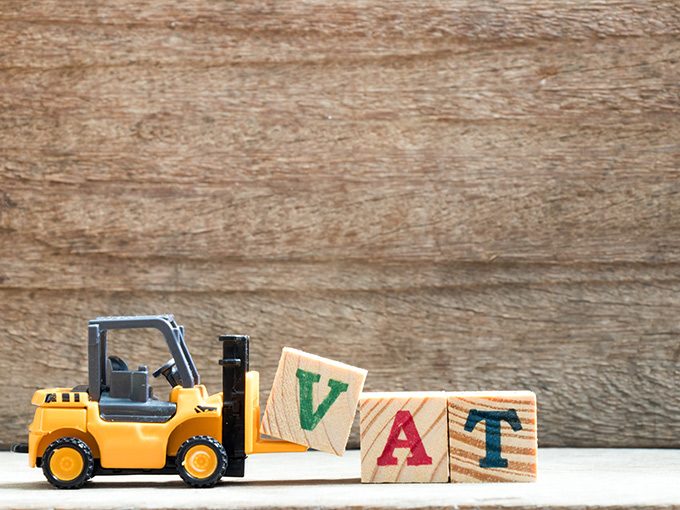This month, we comment on:
- Proposed changes to the Capital Goods Scheme,
- HMRC’s crack down on VAT groups in the care sector,
- Government considering how to increase VAT collection in the e-commerce sector and whether to abolish the low value import threshold, and
- Proposed changes to Temporary Admission relief.
As part of a range of measures, the government has announced planned changes to the Capital Goods Scheme (CGS). The changes will be designed to simplify elements of VAT reporting with respect to qualifying capital assets.
The CGS is a mechanism which requires adjustment of input tax recovery over a specified period (10 years for most categories of relevant capital assets) to reflect change in use of the asset between taxable, exempt and/or non-business use.
The first proposed change is the removal of one category of capital assets from the CGS, namely computers/computer equipment. Currently the purchase of an individual computer or an item of computer equipment for at least £50,000 created a CGS asset.
The second proposed change is the increase from £250,000 to £600,000 (exclusive of VAT) with respect to VAT bearing capital expenditure on land, buildings, or civil engineering works. Qualifying expenditure in this respect is acquisition, construction, refurbishment, fitting out, alteration or extension.
The government has cited the benefit of the proposed changes being reduced administration costs. The proposed changes will be implemented within this parliament, but HMRC has not committed to actual date.
Comments
The removal of computers from the scope of the CGS is not a surprise – such capital assets rarely exist.
The increased threshold as described has been under consideration, and it is also not a surprise this proposed change has been announced. Certainly, having less qualifying capital assets being created due to the increase to £600k will result in more simplified VAT reporting for many businesses and organisations. However, it may prompt an increase in applications to HMRC to use partial exemption special methods as some may otherwise be disadvantaged from a VAT recovery perspective if the use of capital expenditure of say £500k will change between taxable, exempt and/or non-business over the following 10 years. It may also influence on when or if business embarks on capital expenditure under £600k which may have wider economic implications. Similarly, it will benefit those that complete non-qualifying capital expenditure in a year when the taxable activities of the business are higher than will be the case in the future. The partial exemption standard method override may also have greater significance for some.
What is clear is that the transitional rules which HMRC implements will be very important and further guidance is eagerly awaited.
Please contact Nick Hart, VAT Partner, for further information.
In Revenue and Customs Brief 2 (2025) HMRC has announced it is no longer accepting VAT group applications which relate to state-regulated care providers with non-state-regulated providers of welfare services.
It has also announced it is immediately contacting businesses which operate through such VAT groups to discuss the arrangements, and following investigation by HMRC, it may issue VAT group termination notices where the conclusion is that the arrangements qualify as tax avoidance.
HMRC has invited impacted businesses to get in touch via a specific email address.
VAT groups including state-regulated and non-state-regulated providers have been adopted to increase VAT recovery, typically with respect to capital expenditure projects. The effect of the VAT group position means supplies to local authorities or NHS Integrated Care Boards would be taxable (yielding VAT recovery entitlement) rather than exempt (which does entitle VAT recovery). HMRC considers such arrangements to be avoidance unless they have been implemented for reasons other than purely higher VAT recovery.
Comments
The VAT group structure in the care sector is not new and has been implemented by many care home providers in particular. HMRC has supposedly been aware of these structures but has chosen now to conclude that it is likely an avoidance measure, which it is seeking to close down. In the Revenue and Customs Brief there is no indication HMRC will look to retrospectively unpick the structure, and termination of existing VAT groups in the sector will likely be applied from a current date.
If your care home business has adopted this VAT group structure, please get in touch with Nick Hart, VAT Partner, to discuss next steps.
It will be interesting to see whether HMRC now look at other structures which are often implemented for VAT efficiency reasons, in a different way, and within the context of potential avoidance.
Despite changes designed to tackle fraud and increase VAT collection in the e-commerce sector by placing online marketplaces liable for VAT on supplies made by merchants selling from their platforms, the government has announced it is to review the position further as there are still challenges in ensuring the correct of amount of VAT is being collected.
Government has invited those with an interest to get in touch to contribute views etc.
Further, in the wake of the US removing low value import relief, government is to review whether to do the same. Currently imports into the UK of a value of less than £135 are not subject to duty or import VAT – it has been thought the cost of collecting taxes on such low value imports exceeds the amount in VAT and duty being collected.
The outcome of both reviews is awaited with interest.
Comments
Online marketplaces (eg Amazon) are in some circumstances liable for the VAT due on sales of goods and services made by third merchants to consumers. This is to ensure VAT collection on e-commerce transactions is maximised, and without this liability on the platforms, VAT due on sales made by non-resident suppliers in particular has been identified as being under significant risk of not being reported and collected. The outcome of the government’s review on whether additional measures can be taken to further improve VAT collection, will be interesting, and some innovative thinking is likely going to be required. It is heartening that government is willing to involve the sector in considering whether more can do.
The possibility of the UK removing entirely the low value import threshold of £135 is interesting as it would prevent certain practices of under-valuing shipments to stay below the threshold, from having the desired effect of no duty or import VAT applying.
Please get in touch with Nick Hart, VAT Partner, if you operate an online marketplace platform, you are a merchant selling from such platforms, or you import low value goods into the UK.
Government recently published its response to the 2023 Call for Evidence on the Temporary Admission (TA) procedure, which allows goods to be brought into the UK temporarily without customs duties or import VAT becoming due.
The TA procedure has been particularly beneficial to businesses operating within sectors such as the arts, where goods often move in and out of the UK for events, productions, exhibitions etc. The Call for Evidence has highlighted that while TA is an exceptionally beneficial scheme, the process to apply for it is overly complicated, and unclear guidance limits accessibility to TA.
Government has now committed to reforms to improve the TA procedure, to be implemented during 2025. These reforms will see an extension and simplification to the timing requirements. The limits for how long certain goods can remain under TA will be increased, notably, for works of art and antiquities, goods used in tests, demonstrations or experiments, and pleasure-craft. Further, the time limit for completing customs formalities will also be increased to 90-days following the sale of applicable goods.
The user experience is also to see reform as the government are intending to publish new guidance, including a handbook for TA users to simplify the TA process.
Further specific restrictions from TA eligibility are also to be removed, mainly allowing for third-party businesses to use TA on behalf of importers. Currently, an importer usually needs to hold their own authorisation to use TA, rather than engaging another business such as a freight forwarder to hold the authorisation on their behalf. The new improvements will rectify this issue.
Comments
The proposed changes to the TA regime are welcomed and we look forward to HMRC’s new guidance on when it can be applied and the rules which need to be met to do so successfully. TA is just one of a raft of customs reliefs which are available, and it is hoped the scope and administration of other reliefs will also be reviewed, with the aim of making them more accessible and more efficient to apply.
For further details of customs reliefs including temporary admission, please contact Nick Hart, VAT Partner.
Contact us
Partner, Bristol
Key experience





